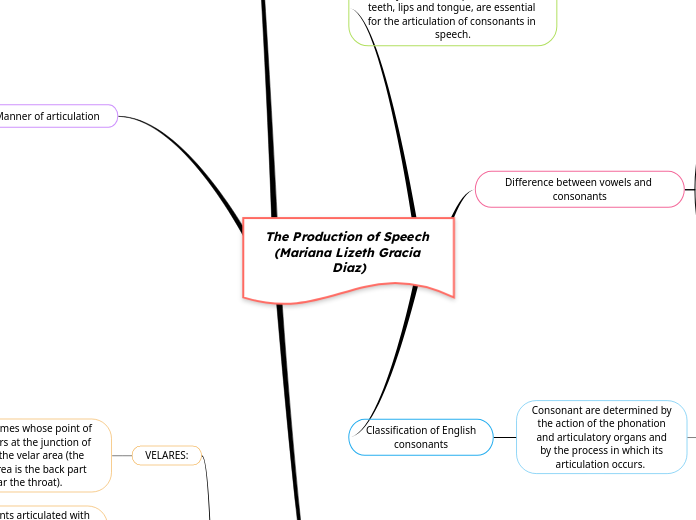The Production of Speech (Mariana Lizeth Gracia Diaz)
point of articulation
BILABIAL:
Bilabial phonemes are phonemes whose point of articulation occurs at the junction of the two lips.
LABIO-DENTAL:
These are phonemes whose point of articulation occurs at the junction of the lower lip with the upper teeth.
DENTAL:
Dental phonemes are phonemes whose point of articulation occurs at the junction of the tongue with the upper teeth.
ALVEOLARS:
These are phonemes whose point of articulation occurs at the junction of the tongue with the alveolar region (the alveoli or alveolar area is the part located just above the teeth).
POST-ALVEOLAR:
It is a consonant articulated with the tongue close to or touching the back of the alveolar region, further back in the mouth than an alveolar consonant, which articulates just above the dental alveolus, but not as far back as the hard palate (the place where palatal consonants are articulated).
PALATO-ALVEOLAR:
It is articulated with the tongue blade behind the alveolar ridge, and the front part of the tongue is grouped on the palate.
PALATALS:
They are consonants articulated with the body of the tongue raised against the hard palate (the middle part of the upper cavity of the mouth).
VELARES:
These are phonemes whose point of articulation occurs at the junction of the tongue with the velar area (the velum or velar area is the back part of the mouth near the throat).
Manner of articulation
APPROXIMALS:
Approximant includes constant sounds that are created by very less obstruction to the airflow. Semivowels with very less obstruction such as [w] in ‘wet’ and [j] in ‘yet’ and [r] in ‘read’.
[w, j, r]
LATERAL:
In lateral, there is complete closure of air in the center of the vocal tracts and air flows through the sides of the tongue. The example of lateral sound is [l] as in word ‘late’.
[l]
AFRICATED:
Is similar to plosive but it does not remain stop for a long time. Unlike plosive, the air is released slowly in affricate.
This articulation occurs when a fricative is followed by a plosive with the same place of articulation. There are two affricate in English that are [tʃ] in sound of ‘church’ and [dʒ] in sound of ‘judge’.
[tʃ, dʒ]
FRICATIVES:
When we push air through a narrow gap to create a hissing noise, we make a fricative consonant. Sometimes, this hissing sound is voiced fricative such as [v, ð, z, ʒ], and sometime it is voiceless such as [f, θ, s, ʃ, h].
[f, v, θ, ð, s, z, ʃ, ʒ, h]
PLOSIVE:
includes those sounds that are made by full obstruction of air in the vocal tract. Thus the sound stop occurs in two steps; the obstruction of air and sudden release of that air.
[p, b, t, d, k, g]
Classification of
English vowels
Vowels are not always
possible to use purely
articulatory criteria, given
the difficulty of observing
articulatory movements,
so we also have to take
into consideration an
auditory point of view.
Classification of English
consonants
Consonant are determined by
the action of the phonation
and articulatory organs and
by the process in which its
articulation occurs.
Difference between vowels and consonants
Consonants are produced by stopping the air, there are 24.
Vowels are the sound that does not find obstruction when it comes out, there are 20.
The different areas within the oral cavity, such as the palate, alveoli, teeth, lips and tongue, are essential for the articulation of consonants in speech.

